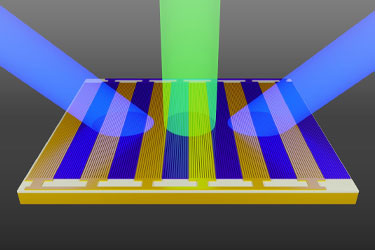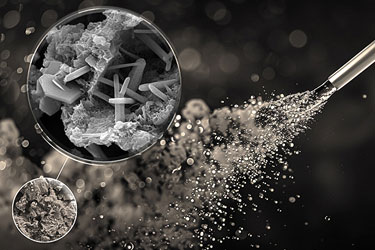Novel RNA Construction Module Enables Efficient Production of High-Density RNA Microarrays
Background and Challenges of RNA Microarray Production Technology
About 40 years ago, a method for chemically synthesizing DNA and RNA was developed that enables the synthesis of any desired sequence from DNA or RNA building blocks by phosphoramidite chemistry. Using these specialized chemical building blocks, nucleic acid strands can be assembled step by step. However, each building block carries a chemical "protecting group" that prevents unwanted reactions from occurring.
This chemistry has also been applied to the production of microchips, which allow for the simultaneous synthesis and analysis of massive amounts of sequence on a solid surface the size of a fingernail. However, due to the relatively poor stability of RNA itself, the application of this technology to the production of RNA microchips has faced great difficulties.

Development and Advantages of a Novel RNA Construction Module
An international research team led by the University of Vienna, Austria, has achieved a major breakthrough by successfully developing an RNA building block with higher chemical reactivity and photosensitivity. This innovation is so significant that it could significantly reduce the production time of RNA microarrays for biotechnology and medical research, halving the production time and increasing the efficiency by a factor of seven. The results were published on July 31 in the journal Science Advances.
The team at the Institute of Inorganic Chemistry at the University of Vienna and the Max Mousselon Institute for Biomolecular Research at the University of Montpellier, France, collaborated on the development of this new RNA building block. The full-size, high-density RNA microchip is capable of holding up to 780,000 unique RNA sequences, each occupying an area of approximately 14 × 14 μm².
RNA aptamer research and application prospects
The paper describes a study of RNA aptamers, small oligonucleotides that bind specifically to target molecules. The researchers carefully selected two "luminescent" aptamers that fluoresce when bound to a dye and synthesized thousands of aptamer variants on a chip. The fact that a single experiment was sufficient to obtain data on all the variants simultaneously opens up entirely new avenues for identifying improved aptamers with better diagnostic properties.
High-quality RNA microarrays are particularly valuable in the rapidly growing field of non-invasive molecular diagnostics, and RNA aptamers will be one of the most immediate applications, for example, in tracking hormone levels in real time, or monitoring other biomarkers directly from sweat or saliva.
MORE FROM WIRED

- Apple's fall event: iPhone 16 series makes a stunning debut

- Space-Time Metasurfaces: Unlocking a New Future for Wireless Communications and Optical Applications

- Innovative Applications of Drone Technology in Agriculture
- Aug,21,2024

- OpenAI Launches SearchGPT, an Innovative AI Search Engine
- Aug,19,2024

- Google Pixel 8A: AI technology-enhanced, the king of price-performance ratio
- Aug,07,2024

- Application of 5G in Intelligent Transportation System
- Aug,01,2024

- A New Process for Concrete Manufacturing: A Breakthrough in Efficient CO2 Sequestration and Quality Assurance
- Jul,25,2024